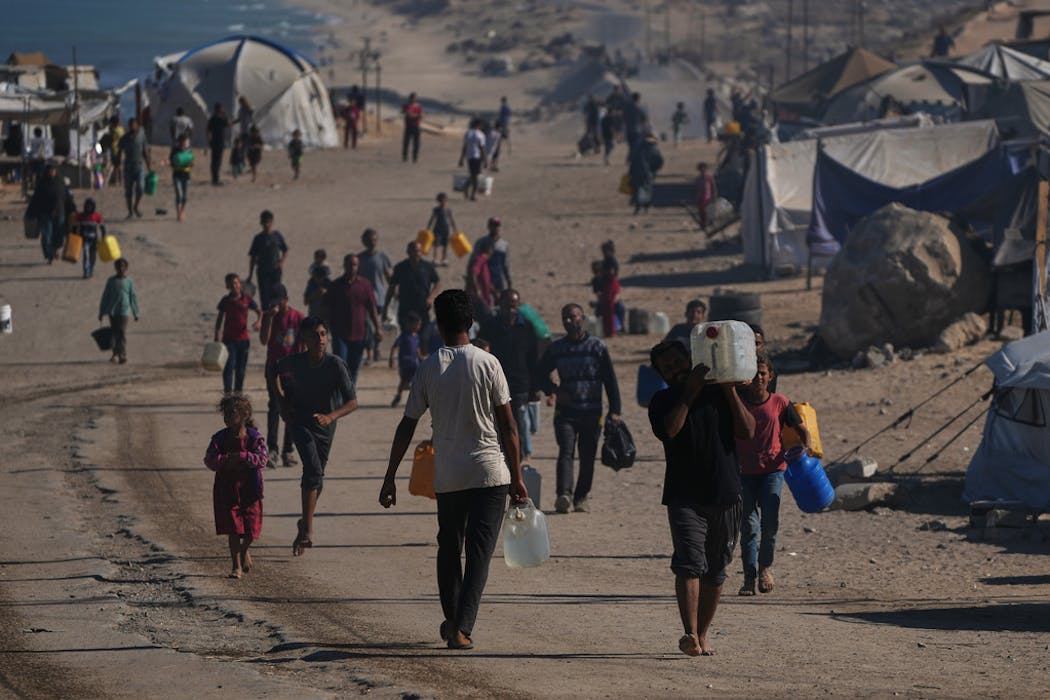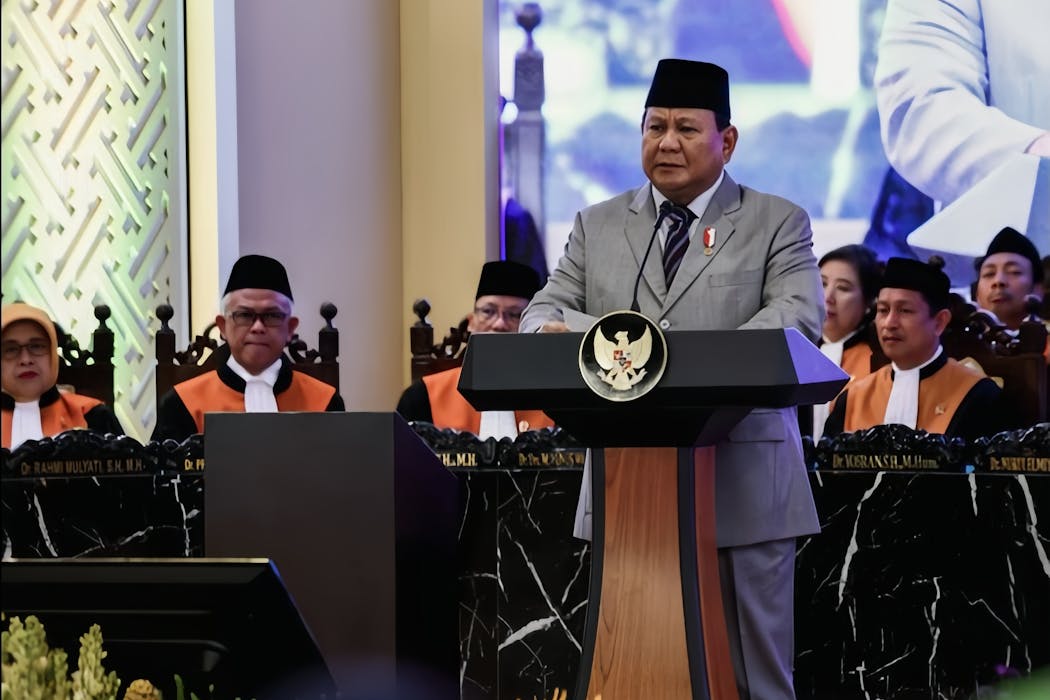Gaza peace plan risks borrowing more from Tony Blair’s failures in the Middle East than his success in Northern Ireland
- Written by Dana El Kurd, Assistant Professor of Political Science, University of Richmond

Tony Blair, the man being tapped by U.S. President Donald Trump[1] to help oversee governance of a postwar Gaza, has ample experience with peace processes.
As British prime minister, Blair helped usher through the 1998 Good Friday Agreement[2] that did much to end decades of sectarian violence in Northern Ireland. After leaving office, he was also special envoy to the so-called Quartet[3] – a diplomatic effort to find a lasting solution to the Israeli-Palestinian conflict.
As Hamas’ Oct. 7, 2023, attack on Israel and the subsequent devastation in Gaza, described recently as genocide by a U.N. body[4], make clear, that attempt failed.
The 20-point peace plan[5] that negotiators are currently discussing in Egypt is light on details. But it outlines the return of the remaining Israeli hostages held by Hamas, the demilitarization of the Gaza Strip and the creation of an international security force to operate on the ground. Notably, the plan does not support the removal of Palestinians from Gaza[6] – something that was present in previous proposals[7] by the Trump administration and which human rights advocates noted amounts to ethnic cleansing[8].
On Oct. 8, 2025, Trump announced that an initial phase[9] involving the exchange of hostages for prisoners and a pause in fighting had been agreed upon. But negotiations continue on sticking points, including the disarming of the militant group.
Among other things, the deal also provisions a postwar Gaza governed by an interim “technocratic” and “apolitical” Palestinian committee. This temporary body will be overseen by a “Board of Peace[10]” run by Trump himself. Other unspecified members will be added, but the only one mentioned in the proposals is Blair, who according to reports[11] had been in talks with the Trump administration for some time crafting the current peace plan.
As a scholar of international relations and Palestinian politics[12], I fear the proposal contains the same limitations and failings that plagued previous peace plans pushed on Palestinians from outside bodies – including both Blair’s Quartet efforts and the earlier Oslo Accords[13] – and too little of what made Northern Ireland peace stick.
A plan rooted in ‘illiberal peace’
The biggest shortcoming critics find with the current plan is that it does nothing to definitively address[14] the right of Palestinians to self-determination and sovereignty[15] – a right enshrined in international law.
Nor does the plan include any meaningful Palestinian input, either through legitimate representatives of the Palestinian people or through mechanisms to ensure the Palestinian public’s buy-in.
Instead, the new framework is asymmetric, providing the Israeli government many of its political objectives[16] while imposing multiple layers of international control on and vague assurances to the Palestinian people – and only if they comply.
As such, the plan continues the trend of what political scientists describe as “illiberal peace” in conflict resolution.
In a 2018 paper, scholars described an “illiberal peace[17]” as one in which “cessation of armed conflict is achieved in ways that are … unashamedly authoritarian.” Such a peace is achieved through “methods that eschew genuine negotiations among parties to the conflict, reject international mediation and constraints on the use of force, disregard calls to address underlying structural causes of conflict, and instead rely on instruments of state coercion and hierarchical structures of power.”
Past examples include conflict management in the Kurdish region of Turkey[18], Chechnya[19] under Russian control and the ethnic cleansing of Nagorno-Karabakh[20].
The Northern Ireland case study
That stands in contrast to peace agreements that have succeeded elsewhere using more inclusive diplomatic frameworks, like in Northern Ireland[22].
For 30-plus years, the territory was engulfed in sectarian violence between the mainly Protestant “loyalists” who wanted to remain part of the U.K. and the Catholic minority that wished to be part of a united, independent Irish republic.
To end this armed conflict, the peace process[23] included all relevant parties, including militant groups on all sides.
The Northern Ireland peace process also explicitly engaged with the Irish public and offered the people input through two separate referendum votes[24]. People in Northern Ireland voted on whether to support the plan, and people in the Republic of Ireland voted on whether to authorize the Irish state to sign the agreement.
This inclusive and democratic process has been able to sustain a cessation of conflict for the past 27 years.
While Blair didn’t start the Northern Ireland peace process, his government played a pivotal role, and it was he who memorably noted “the hand of history[25]” on the shoulder of those involved in the final days of negotiation.
A failed Oslo counterexample
The Northern Ireland process stands in direct contrast to many of the failed peace processes attempted in the Middle East, which fall more in line with the “illiberal peace” concept.
The most serious push for lasting peace was the Oslo Accords in 1993[26], in which the Palestine Liberation Organization accepted Israel’s right to exist, forgoing its claims to much of historic Palestine, in return for Israel’s acknowledgment of the PLO as the legitimate representative of the Palestinian people.
That process led to the creation of the Palestinian Authority, which was meant to exercise limited governance on an interim basis, and presidential and parliamentary elections in order to facilitate the input of the Palestinian public. But as many former U.S. officials have since admitted, the accords were asymmetric[27]: They offered Palestinians recognition under the PLO but little pathway to achieve a negotiated solution under conditions of occupation by a far more powerful sovereign country.
That peace process fell apart when that asymmetry became clear. The two parties meant very different things when they used the word “state.” The Israel government envisioned some form of limited self-governance[29] for the Palestinians and continued its settlement expansion and military occupation. The Palestinians, on the other hand, envisioned a legitimate state exercising sovereignty.
Adding to the problems, Palestinians never had equal negotiating power, and the accords lacked a neutral arbiter[30] in the U.S., the leading mediator.
Oslo was intended to be a time-limited process to give negotiators space to resolve outstanding conflict issues. In practice, it served to give long-term diplomatic cover for a status quo in which Israeli governments moved away from a two-state solution while Palestinians became more politically and geographically fragmented[31] under worsening hardship and violence[32].
The Oslo peace process fell apart in the early years of Blair’s government, at the same time as he was helping put the finishing touches on the Good Friday Agreement.
The necessity of public buy-in and an inclusive process was evident to many onlookers to the divergent fortunes of both peace processes.
Repeating failed lessons in Gaza?
In the Israeli-Palestinian context today, Blair risks repeating the mistakes of Oslo. He is poised to sit on an undemocratic international body overseeing a people under a de facto military occupation.
Further, while the Trump plan is reliant on Hamas’ approval, there is no role for the group after the initial stage. In fact, the framework explicitly states that Hamas must be excised from any future discussions of postwar Gaza. Moreover, no other Palestinian group has any direct involvement; Hamas’ main rival Fatah – the party that is in control of the Palestinian Authority in the occupied West Bank – is only briefly mentioned. As for that Palestinian Authority, there is only a vague line about reforming the body.
Similarly, there has been no mention of what the Palestinian people might actually want. In this way, the body being proposed recalls the creation of the U.S.-led Coalition Provisional Authority during the invasion of Iraq. That body governed Iraq immediately following the invasion and was criticized for corruption and lack of transparency[34].
The failure of the Iraq War, and the U.K.’s involvement in it, contributed to Blair’s resignation as prime minister[35] in 2007, after which he took on the role of special envoy to the Quartet[36]. Led by the U.N., U.S., EU and Russia, the Quartet was tasked with preserving some form of the two-state solution and implementing economic development plans in Palestinian cities.
But it, too, failed to address the changing political realities on the ground as Israeli settlements expanded[37] and the military occupation deepened.
The underlying assumption about the Quartet, critics contend, is that it largely ignored the Palestinian right to self-determination and sovereignty; rather, it focused on marginally improving economic conditions and Band-Aid initiatives.
The latest U.S.-backed proposal cribs heavily from the approach. Even if it does bring about a welcome respite from the suffering in Gaza in the short term, I believe a durable, mutually agreed upon resolution to the decades-long Israeli-Palestinian conflict requires what Trump’s plan sidelines: Palestinian self-determination.
In Northern Ireland, Blair once understood the importance of neutral mediation and the buy-in of all parties to the conflict and the people themselves. The plan he is involved with now appears to be operating with a far different calculus.
References
- ^ tapped by U.S. President Donald Trump (www.npr.org)
- ^ Good Friday Agreement (www.ireland.ie)
- ^ special envoy to the so-called Quartet (www.quartetoffice.org)
- ^ genocide by a U.N. body (www.ohchr.org)
- ^ 20-point peace plan (www.bbc.com)
- ^ removal of Palestinians from Gaza (www.hrw.org)
- ^ present in previous proposals (www.ap.org)
- ^ amounts to ethnic cleansing (www.hrw.org)
- ^ announced that an initial phase (apnews.com)
- ^ Board of Peace (english.alarabiya.net)
- ^ according to reports (www.npr.org)
- ^ scholar of international relations and Palestinian politics (www.danaelkurd.com)
- ^ Oslo Accords (theconversation.com)
- ^ nothing to definitively address (www.aljazeera.com)
- ^ self-determination and sovereignty (www.law.cornell.edu)
- ^ many of its political objectives (www.theguardian.com)
- ^ scholars described an “illiberal peace (doi.org)
- ^ Kurdish region of Turkey (www.rcmediafreedom.eu)
- ^ Chechnya (www.taylorfrancis.com)
- ^ Nagorno-Karabakh (freedomhouse.org)
- ^ Dan Chung/Pool Photo via AP, File (newsroom.ap.org)
- ^ like in Northern Ireland (www.bbc.com)
- ^ end this armed conflict, the peace process (www.ireland.ie)
- ^ two separate referendum votes (www.ulstermuseum.org)
- ^ the hand of history (www.theguardian.com)
- ^ Oslo Accords in 1993 (theconversation.com)
- ^ accords were asymmetric (www.jpost.com)
- ^ AP Photo/Dennis Cook (newsroom.ap.org)
- ^ envisioned some form of limited self-governance (www.palquest.org)
- ^ lacked a neutral arbiter (www.middleeasteye.net)
- ^ more politically and geographically fragmented (www.aljazeera.com)
- ^ worsening hardship and violence (www.mei.edu)
- ^ AP Photo/Majdi Mohammed (newsroom.ap.org)
- ^ criticized for corruption and lack of transparency (www.realcleardefense.com)
- ^ resignation as prime minister (www.theguardian.com)
- ^ special envoy to the Quartet (www.un.org)
- ^ Israeli settlements expanded (www.crisisgroup.org)
Authors: Dana El Kurd, Assistant Professor of Political Science, University of Richmond





